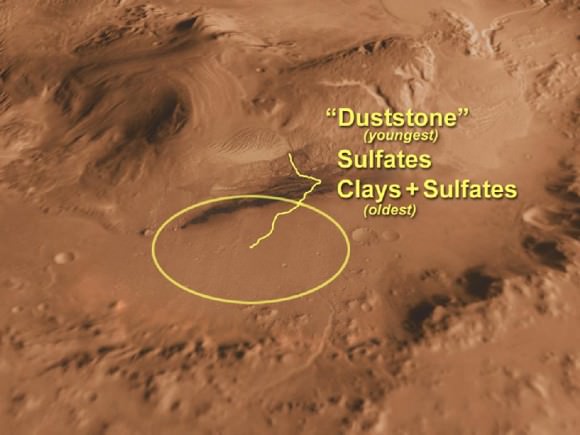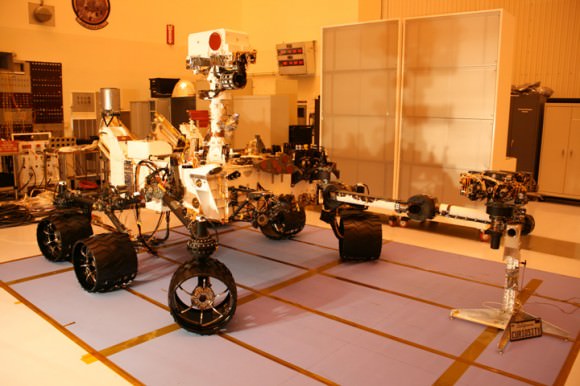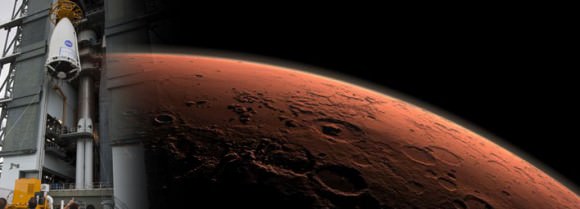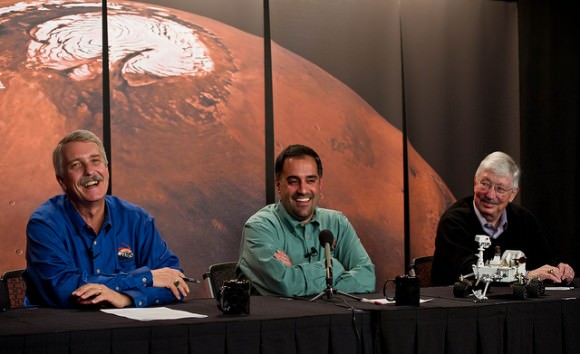[/caption]
Nov 19 Update: MSL launch delayed 24 h to Nov. 26 – details later
In just 7 days, Earth’s most advanced robotic roving emissary will liftoff from Florida on a fantastic journey to the Red Planet and the search for extraterrestrial life will take a quantum leap forward. Scientists are thrilled that the noble endeavor of the rover Curiosity is finally at hand after seven years of painstaking work.
NASA’s Curiosity Mars Science Laboratory (MSL) rover is vastly more capable than any other roving vehicle ever sent to the surface of another celestial body. Mars is the most Earth-like planet in our Solar System and a prime target to investigate for the genesis of life beyond our home planet.
Curiosity is all buttoned up inside an aeroshell at a seaside launch pad atop an Atlas V rocket and final preparations are underway at the Florida Space Coast leading to a morning liftoff at 10:25 a.m. EST on Nov. 25, the day after the Thanksgiving holiday.
“MSL is ready to go,” said Doug McCuistion, director of the Mars Exploration Program at NASA Headquarters in Washington, at a media briefing. “It’s a momentous occasion. We’re just thrilled that we’re at this point.”
“Curiosity is ‘Seeking the Signs of Life’, but is not a life detection mission. It is equipped with state-of-the-art science instruments.”

“It’s not your father’s rover. It’s a 2000 pound machine that’s over 6 feet tall – truly a wonder of engineering,” McCuistion stated.
“Curiosity is the best of US imagination and US innovation. And we have partners from France, Canada, Germany, Russia and Spain.”
“Curiosity sits squarely in the middle of our two decade long strategic plan of Mars exploration and will bridge the gap scientifically and technically from the past decade to the next decade.”
“Mars Science Laboratory builds upon the improved understanding about Mars gained from current and recent missions,” said McCuistion. “This mission advances technologies and science that will move us toward missions to return samples from and eventually send humans to Mars.”

The car sized rover is due to arrive at Mars in August 2012 and land inside Gale Crater near the base of a towering and layered Martian mountain, some 5 kilometers (3 miles) high. Gale Crater is 154 km (96 mi) in diameter.
The landing site was chosen because it offers multiple locations with different types of geologic environments that are potentially habitable and may have preserved evidence about the development of microbial life, if it ever formed.
Gale Crater is believed to contain clays and hydrated minerals that formed in liquid water eons ago and over billions of years in time. Water is an essential prerequisite for the genesis of life as we know it.

The one ton robot is a behemoth, measuring 3 meters (10 ft) in length and is nearly twice the size and five times as heavy as NASA’s prior set of twin rovers – Spirit and Opportunity.
Curiosity is equipped with a powerful array of 10 science instruments weighing 15 times as much as its predecessor’s science payloads. The rover can search for the ingredients of life including water and the organic molecules that we are all made of.
Curiosity will embark on a minimum two year expedition across the craters highly varied terrain, collecting and analyzing rock and soil samples in a way that’s never been done before beyond Earth.
Eventually our emissary will approach the foothills and climb the Martian mountain in search of hitherto untouched minerals and habitable environments that could potentially have supported life’s genesis.
With each science mission, NASA seeks to take a leap forward in capability and technology to vastly enhance the science return – not just to repeat past missions. MSL is no exception.
Watch a dramatic action packed animation of the landing and exploration here:
Curiosity was designed at the start to be vastly more capable than any prior surface robotic explorer, said Ashwin Vasavada, Curiosity’s Deputy Project Scientist at NASA’s Jet Propulsion Laboratory in Pasadena, Calif
“This is a Mars scientist’s dream machine.”
Therefore this mission uses new technologies to enable the landing of a heavier science payload and is inherently risky. The one ton weight is far too heavy to employ the air-bag cushioned touchdown system used for Spirit and Opportunity and will use a new landing method instead.
Curiosity will pioneer an unprecedented new precision landing technique as it dives through the Martian atmosphere named the “sky-crane”. In the final stages of touchdown, a rocket-powered descent stage will fire thusters to slow the descent and then lower the rover on a tether like a kind of sky-crane and then safely set Curiosity down onto the ground.
NASA has about three weeks to get Curiosity off the ground from Space Launch Complex 41 at Cape Canaveral Air Force Station in Florida before the planetary alignments change and the launch window to Mars closes for another 26 months.
“Preparations are on track for launching at our first opportunity,” said Pete Theisinger, MSL project manager at NASA’s Jet Propulsion Laboratory (JPL) in Pasadena, Calif. “If weather or other factors prevent launching then, we have more opportunities through Dec. 18.”

Complete Coverage of Curiosity – NASA’s Next Mars Rover launching 25 Nov. 2011
Read continuing features about Curiosity by Ken Kremer starting here:
Curiosity Rover Bolted to Atlas Rocket – In Search of Martian Microbial Habitats
Closing the Clamshell on a Martian Curiosity
Curiosity Buttoned Up for Martian Voyage in Search of Life’s Ingredients
Assembling Curiosity’s Rocket to Mars
Encapsulating Curiosity for Martian Flight Test
Dramatic New NASA Animation Depicts Next Mars Rover in Action


NASA is simply wasting timeand money trying to find life on that DEAD and DUMB planet that we call MARS.
Agreed!
Umm… how can I put this politely?
“Get the f**k out.”
That works.
To be honest the only thing dead is this country’s enthusiasm for space exploration, and the only dumb things here are the people who come onto a website like this to complain about it.
seems like you`re the only guy here to complain about it …
Problem? Just because I’m the only one complaining doesn’t change the fact that he and Damos are ignorant.
That is argument from silence and has nothing to do with the claim as Bicer notes.
I find Baris Bicer’s analysis, at least, fair.
They should totally start finding life on sun
No research is wasting money a priori, science have observably huge returns.
In any case we don’t know if Mars is or always was without biosphere. It has all the required components for habitability even today: temperature and water compatible with cellular life, CHNOPS elements to build cells, and energy sources to drive cellular metabolism. “A search for organics” is the attempt to find out if chemical and/or biological evolution is or was ongoing.
Even if we had known that Mars was barren, we would be interested in establishing why. Some like me find the evidence pointing to rapid and easy chemical evolution and abiogenesis under diverse conditions. Then the question becomes “why no life here” rather than “where is life”.* But both of these questions are fruitful for astrobiology and culture (as “are we alone” is an old question).
————————
* For small bodies a predictive hypothesis was raised but this year. Turns out the zone of liquid water is thin and too rapidly migrating in these bodies as they aggregate and thaw under energy input from impacts. No abiogenesis for them.
But any body [sic!] above ~ 100 – 200 km, the putative point where they start to differentiate and retain a heated core aside from a slower and deeper early migrating liquid water zone, is a potential bearer of a biosphere at some point. We just have to get to them.
And you know this…how?
Show us the results of your probe, please.
This is a science oriented website for people that actually follow and understand the scientific community, so ignorant and childish trolls like you all should really lurk on sites more in your speed range, like perhaps intouchweekly.com or Jersey Shore fan sites…
this is a very small thinking of a small-church builder. Better you follow your own suggestions. If there are scientists thinking like you, no wonder they get budget cuts every year…i learned a lot reading every article on this site, and so will every “ignorant” reading and “lurking” around here.. .take your 6 “likes” with you and please isolate all on facebook…privacy at maximum so that nobody ever sees you or hears you.
Are you seeing the comments I’m replying to? “NASA is simply wasting timeand money trying to find life on that DEAD and DUMB planet that we call MARS.” Not sure why you’re attacking me when I seem to be on the side of this site and against people making ridiculous, pointless comments like the one I quoted… Did you understand this?
screw you haterz
This mission is a little bit of everything.
Besides testing new precision and heavy mass landing techniques, besides testing new analysis methods, it is a search for the remaining components of habitability. After earlier landers have found temperatures and water enough for liquids, and energy sources (light, thermal vents) and nutrients (perchlorates) enough for redox reactions, one can summarize that as a “search for organics”.
But other perspectives is offered by its companion orbiter MAVEN that will arrive in late 2013.
Together they will research habitability over time and how it decreased to today’s conditions. MAVEN will characterize the water conditions of today by looking at D/H isotope ratios. (The heavier hydrogen isotope deuterium, D, takes longer to loose.)
From Curiosity similar measurements on old rocks, but also earlier observations on Mars and early solar system meteorites, one can model the water loss over time. Intriguingly, researchers seems divided between losses due to the Sun and/or giant impacts stripping atmosphere. That affects habitability too, since the period of heavy impact, roughly corresponding to our own Late Heavy Bombardment I take it, would remove water early.*
And by comparing the weather conditions around Curiosity with the upper atmosphere changes as characterized by MAVEN, it sounds like a sorely needed understanding of Mars atmosphere and its surface actions will be looked for.
Btw, none of these articles gets into the latest findings of potentially no large bodies of water on Mars. As I remember it, there was a global lack of expected minerals from such conditions.
However as in all matters of geology things aren’t clear cut, Mars surface have been extensively reworked and the old surface buried, so hopefully we will get better news. That is after all what we have our Curiosity for.
———————-
* But not early enough for abiogenesis to have taken. Especially since Mars had ~ 30 Ma (million years) added time compared to Earth, it aggregated in perhaps 3 Ma while Earth took around 30 Ma to form.
And if Earth LHB was survivable as models suggest, hopes are that Mars was too despite being smaller and closer to the giant planet interactions that spawned LHB.
“This mission is a little bit of everything” reminds me too much of the sad failure 2 weeks ago of the chinese-whatever mission. I just hope the americans will give us a lesson of the things well done, like they used to in the past.
Mars is the most like Earth in its physical properties of any planetary body in the solar system. This is the most reasonable place to search for life beyond Earth. Mars might be barren in the end, though decent evidence for subterranean water exists, which make life possible.
LC
That video is most annoying, why the stupid sound effects. ? Does it really makes so many buzzing noises? I also have to wonder why it does everything so slowly, especially its top speed, wouldn’t it have made sense to make a vehicle that could move quickly so you could cover more ground.? About the most exciting thing about it is the ‘Pew-Pew’ laser in its eye.
One other caveat, with all the R&D to build one, wouldn’t you make use of modern industrial production lines and make several rovers? Start sending them everywhere? I would love to see what a commercial company could achieve given the mandate. All that money the 1% of the world own is doing nothing as far as I can tell.
Anyway, good luck to the team, exciting mission regardless. Fingers crossed there isn’t a Mars curse on at the moment. (thinking of sad Phobos – Grunt stuck in Orbit)
Unless Phobos- Grunt wanted a travel companion and will fire its rockets……. ‘nah’ 🙂
“I also have to wonder why it does everything so slowly, especially its top speed, wouldn’t it have made sense to make a vehicle that could move quickly so you could cover more ground.?’
This isn’t an R/C car that’s right in front of you. Speed of light delays in control being what they are, you have to plan ahead carefully, and you don’t *want* to move too fast. This isn’t about speed. If it lands successfully, there should be plenty of time, and it can’t do much research in motion, anyway. Most of the time, it *will* be stopped.
“About the most exciting thing about it is the ‘Pew-Pew’ laser in its eye.”
That isn’t the kind of excitement it’s hoped to deliver. Movie special effects have jaded too many of us.
“One other caveat, with all the R&D to build one, wouldn’t you make use of modern industrial production lines and make several rovers?”
Yes…but more than rover means more than one launcher (or one larger one,which, for those same economies of scale reasons, could cost more than two smaller ones), and that’s significantly more money, for an already very expensive program.
The speed is set by the autonomous software. They did a great job on the earlier rovers software, the speed went up some factor two I think. They had to dial it down after hitting Purgatory, but it has been creeping up again was my impression.
And that software is likely the prototype for this one, which should be improved over time.
However in the earlier rovers they put in a top speed of ~ 5 cm/s, while they could only get ~ 1 cm/s out of the software. This rover is better optimized with a top speed of ~ 4 cm/s and, maybe, getting ~ 2 cm/s from the software.
That is ~ 7 km/h, and a bit better than walking speed (~ 5 km/h). First you learn to crawl, then walk.
I wonder if it’s possible to have a permanent rover delivery system in place on Mars so that NASA can save money on each mission. Perhaps it can be a crane like this one, but it wouldn’t crash land on the surface, instead it would rise back up to orbit where it can be re-used for the next rover.
People have the know-how to make methane from CO2 and H2 via the Sabatier reaction. Oxygen can be cracked from CO2. Hydrogen though may have to be transported with each new rover.
Alternatively, you could ship out reasonable quantities of water along with each rover. The water can then be split into LOX/LH2 to use as propellant for the crane-delivery-system.
Just my musings..
I like the concept, but I’m not so sure that’s practical… you’d have to design each rover to be compatible with the existing crane, which could be too restrictive. The crane itself would have to carry an awful lot of fuel to get back up into orbit. And it would have to somehow be able to carry with it a protective re-openable shell allowing it to repeat atmospheric re-entry.
And if the system ever gets damaged or takes too much wear and tear (which I imagine wouldn’t take long), it would have to be scrapped, because it can’t be repaired on site. I suspect it’s always going to be cheaper to send a new crane (or whatever) with each lander.
The delivery system seems incredibly complex which makes me worry for the reliability but I wish it the very best of luck, as I did Phobos-grunt 🙁 What will be interesting will be how humanity’s global psyche will react if life *is* discovered on Mars. Which newspaper will produce the stupidest headline and what will it be? The theological debates alone will be worth all the expense. My money is on lots of overhyped fuss and then when everyone realises it’s just a micro-organism then interest will fade completely apart from the cranks. The scientists will then want to bring some back here to study which will generate even more stupid headlines, it certainly would make life on Earth far more interesting.
I actually worked for the company that aided in the development of the Skycrane landing system and ALHAT (Autonomous Landing and Hazard Avoidance). The Skycrane is in fact named after the S-64.